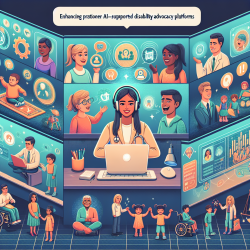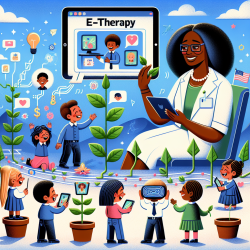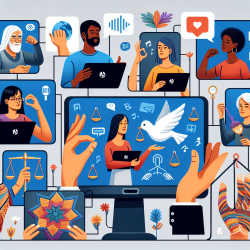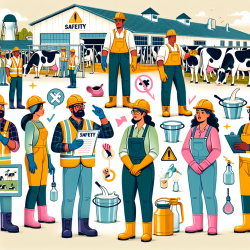Introduction
In the realm of speech-language pathology, practitioners are constantly seeking ways to improve outcomes for children with disabilities. A recent study titled A Virtual Community for Disability Advocacy: Development of a Searchable Artificial Intelligence–Supported Platform provides a novel approach to disability advocacy, leveraging artificial intelligence (AI) and health informatics to create a virtual community that supports disability rights. This blog explores how practitioners can implement the outcomes of this research to enhance their skills and contribute to better outcomes for children.
Understanding the Platform
The research outlines the development of a virtual community platform using AI techniques such as Semantic Web, machine learning, and natural language processing. This platform is designed to facilitate the uploading, sharing, and accessing of disability data. It includes a multilingual search engine capable of intelligent semantic searches, allowing users to query disability-related documents effectively.
Key Features and Benefits
- Data Accessibility: The platform provides a centralized repository for disability data, making it accessible to practitioners, researchers, and advocacy groups.
- Semantic Search: The use of natural language processing enables users to perform complex searches in multiple languages, enhancing the retrieval of relevant information.
- Community Engagement: By allowing information producers, consumers, validators, and administrators to interact, the platform fosters a collaborative environment for knowledge sharing.
Implementing the Research Outcomes
Practitioners can leverage this platform to enhance their understanding and advocacy efforts in several ways:
- Data-Driven Decisions: Utilize the platform's extensive data to make informed decisions regarding therapy approaches and advocacy strategies.
- Collaboration: Engage with a community of experts and stakeholders to share insights and best practices, enhancing the collective knowledge base.
- Continuous Learning: Stay updated with the latest research and policy developments by accessing the platform's comprehensive database.
Encouraging Further Research
While the platform offers significant advancements, it also highlights the need for continuous research and development. Practitioners are encouraged to explore further research opportunities, such as:
- Evaluating User Needs: Conduct studies to understand the specific needs of different user groups and tailor the platform's features accordingly.
- Expanding Multilingual Capabilities: Enhance the platform's language support to include more languages, making it accessible to a broader audience.
- Improving AI Algorithms: Collaborate with AI researchers to refine machine learning models, ensuring accurate tagging and retrieval of information.
Conclusion
The development of a virtual community for disability advocacy represents a significant step forward in utilizing technology to support disability rights. By implementing the outcomes of this research, practitioners can improve their skills and contribute to better outcomes for children with disabilities. For those interested in delving deeper into the research, the original paper can be accessed here.










